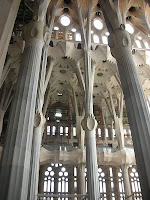Have you heard about Orlan?
Orlan is a French artist famous for her performances and her conception of body. Indeed, she considers her body as an artistic medium. She gets dress up and uses esthetic surgergy in order to metamorphose herself. These transformations belong to an entire artistic approach and become a way of creation. She always has fun by provocation.
People mostly rembember Orlan’s trash works like Omniprésence (1993, esthetic surgery on her face) but I want to speak about another aspect of her Work.
Sometimes her happenings take place in the street. Orlan chooses places which are quite a crowd in order to meet many people. The relationship between the artist and the viewer is inversed. This is not the viewer who meets the work, this is the artist who meets the viewer. The artist directly calls people in the street and the confrontation is the creation. Happenings and performances give to the viewer a place of honor. There is a part of chance in the creation. The viewer is an actor of the work of art and “makes a half of the creation job” !
One of Orlan’s work is particularly representative of the questions raised by happenings. In “Le Baiser de l’Artiste”, Orlan was waiting in the street with a banner that announced “free kiss of the artist!”. She called the crowd by crying “who wants a kiss from the artist?”. The event was filmed by journalists and in videos, we can see some people who were very shocked while other were very amused and gave kisses to Orlan.
Watch the video of the happening:
Viewers’ reactions are a primordial point of the work. The work cannot exist by itself, an interaction with the viewer is necessary. As a matter of fact, this happening is not a material thing, this is an idea, a concept, an event and a remind.
What is the limit between art and non-art?
This happening is one part of Orlan’s entire Work. Her artistic point of view and the importance of body are still the same. She wonders the common idea of the woman’s body in society. Can we pay for a kiss? Can a woman be only a sexual attractive body? Can human body become a kiss robot?
I stay dubitative about several works of Orlan. Her provocations and her works about esthetic surgery show that she is such a crazy woman! I found this happening representative of what kind of artistic events artists can organize with people in the street.
Interview of Orlan, she speaks about "Le baiser de l'artiste":
































